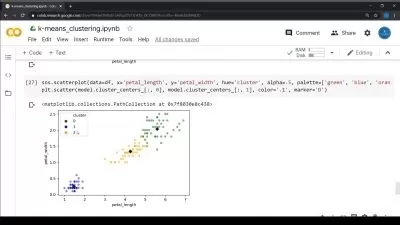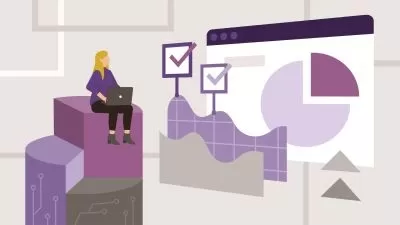Economics of Power Stations using Data Science
Dr. Spyros Giannelos
6:37:47
Description
Economics & Data Analysis (Python & Optimisation/ pyomo) applied to Power Stations
What You'll Learn?
- Theory of Power Station Economics
- Calculating wind patterns for wind farms using Python
- Technical characteristics of Power stations
- How electricity generators determine the wholesale price, using Python
- Modelling the Hydroelectric power plants, using Python
- Costs, Revenues & Subsidies for Power Stations
- Capital Costs, Levelized Cost of Electricity - explanation & examples
- Optimization (pyomo): Optimal strategy of Power Stations on spot & wholesale electricity markets
- Data analysis on electricity generation datasets
- Part of the giannelos dot com official certificate for high-tech projects.
Who is this for?
More details
Description
What is the course about:
This course teaches everything about the most important part of Electricity systems:Â Power Stations, also known as electricity generation units, or simply "units".
We begin with an in-depth presentation of the Theory of Power Station technologies going through Hydro Electric power stations, which we also model on Python, and also wind farms - and we compare offshore versus onshore farms in terms of investment - and also tidal/geothermal / biomass units as well as we model fundamental techno economics of wind farms such as the development of wind patterns using Python.
We also discuss, in-depth, the technical characteristics of power stations, such as capacity factor, ramp rate, efficiency, minimum stable generation, installed capacity accounting for transmission and distribution losses, dispatchability and flexibility among others.
We move on by developing a Python executable file, from scratch, which models the operation of electricity generators and show how they dynamically affect the wholesale electricity price. We can use this application for studying the interaction between wholesale electricity price, merit order and marginal generation costs, which we define and view in practice, using Python.
We then proceed with the Economics of Power Stations., starting with fundamental costs, such as Capital Costs, and Levelized Cost of Electricity for different electricity generation types; we develop the LCOE, and we plot it and explain it.
We proceed to the Revenue, and specifically - subsidies for electricity generation units. We analyse contracts for difference, and the Renewables Obligation scheme - we build the model from scratch in Excel and Python.
We also use Pyomo and perform optimization to determine the optimal strategy of power stations in spot electricity markets and wholesale electricity markets with the objective being to maximize the revenue.
Finally, we learn about how to perform Data Analysis on all possible structures of datasets used for Power Stations and generally electricity generation.Â
 Who:
I am a research fellow at Imperial College London, and I have been part of high-tech projects at the intersection of Academia & Industry for over 10 years, prior to, during & after my Ph.D. I am also the founder of the giannelos dot com program in data science.
Doctor of Philosophy (Ph.D.) in Analytics & Mathematical Optimization applied to Energy Investments, from Imperial College London, and Masters of Engineering (M. Eng.) in Power Systems and Economics.
Important:
Prerequisites: The course Data Science Code that appears all the time at Workplace.
Every detail is explained, so that you won't have to search online, or guess. In the end, you will feel confident in your knowledge and skills.
We start from scratch so that you do not need to have done any preparatory work in advance at all. Just follow what is shown on screen, because we go slowly and explain everything in detail.
Who this course is for:
- Enterpreneurs
- Economists
- Quants
- Members of the highly googled giannelos dot com program
- Investment Bankers
- Academics, PhD Students, MSc Students, Undergrads
- Postgraduate and PhD students.
- Data Scientists
- Energy professionals (investment planning, power system analysis)
- Software Engineers
- Finance professionals
What is the course about:
This course teaches everything about the most important part of Electricity systems:Â Power Stations, also known as electricity generation units, or simply "units".
We begin with an in-depth presentation of the Theory of Power Station technologies going through Hydro Electric power stations, which we also model on Python, and also wind farms - and we compare offshore versus onshore farms in terms of investment - and also tidal/geothermal / biomass units as well as we model fundamental techno economics of wind farms such as the development of wind patterns using Python.
We also discuss, in-depth, the technical characteristics of power stations, such as capacity factor, ramp rate, efficiency, minimum stable generation, installed capacity accounting for transmission and distribution losses, dispatchability and flexibility among others.
We move on by developing a Python executable file, from scratch, which models the operation of electricity generators and show how they dynamically affect the wholesale electricity price. We can use this application for studying the interaction between wholesale electricity price, merit order and marginal generation costs, which we define and view in practice, using Python.
We then proceed with the Economics of Power Stations., starting with fundamental costs, such as Capital Costs, and Levelized Cost of Electricity for different electricity generation types; we develop the LCOE, and we plot it and explain it.
We proceed to the Revenue, and specifically - subsidies for electricity generation units. We analyse contracts for difference, and the Renewables Obligation scheme - we build the model from scratch in Excel and Python.
We also use Pyomo and perform optimization to determine the optimal strategy of power stations in spot electricity markets and wholesale electricity markets with the objective being to maximize the revenue.
Finally, we learn about how to perform Data Analysis on all possible structures of datasets used for Power Stations and generally electricity generation.Â
 Who:
I am a research fellow at Imperial College London, and I have been part of high-tech projects at the intersection of Academia & Industry for over 10 years, prior to, during & after my Ph.D. I am also the founder of the giannelos dot com program in data science.
Doctor of Philosophy (Ph.D.) in Analytics & Mathematical Optimization applied to Energy Investments, from Imperial College London, and Masters of Engineering (M. Eng.) in Power Systems and Economics.
Important:
Prerequisites: The course Data Science Code that appears all the time at Workplace.
Every detail is explained, so that you won't have to search online, or guess. In the end, you will feel confident in your knowledge and skills.
We start from scratch so that you do not need to have done any preparatory work in advance at all. Just follow what is shown on screen, because we go slowly and explain everything in detail.
Who this course is for:
- Enterpreneurs
- Economists
- Quants
- Members of the highly googled giannelos dot com program
- Investment Bankers
- Academics, PhD Students, MSc Students, Undergrads
- Postgraduate and PhD students.
- Data Scientists
- Energy professionals (investment planning, power system analysis)
- Software Engineers
- Finance professionals
User Reviews
Rating
Dr. Spyros Giannelos
Instructor's Courses
Udemy
View courses Udemy- language english
- Training sessions 61
- duration 6:37:47
- Release Date 2023/02/13















